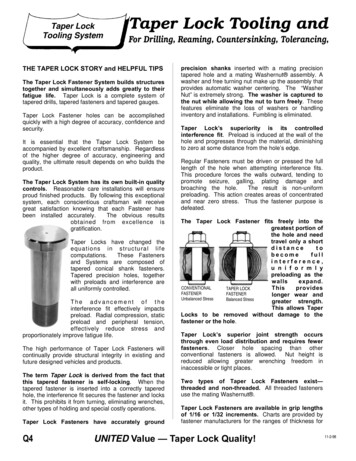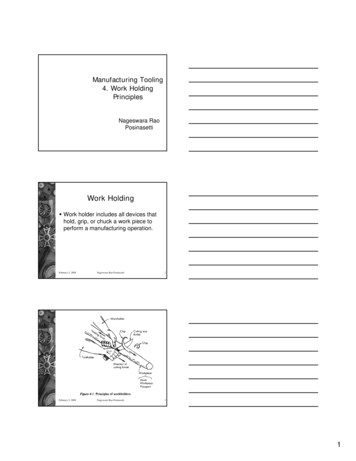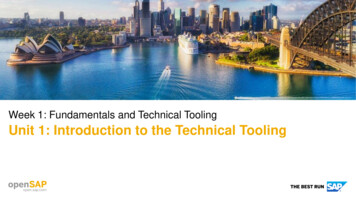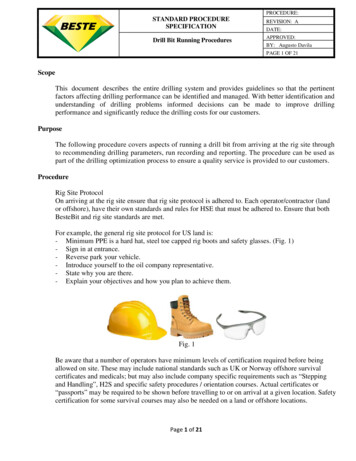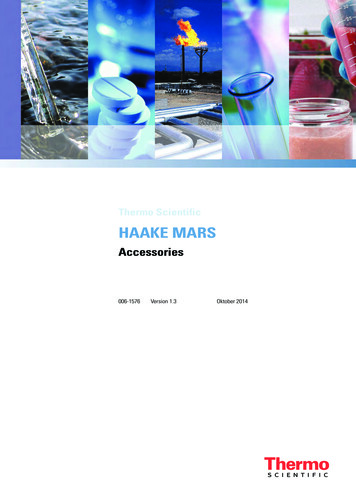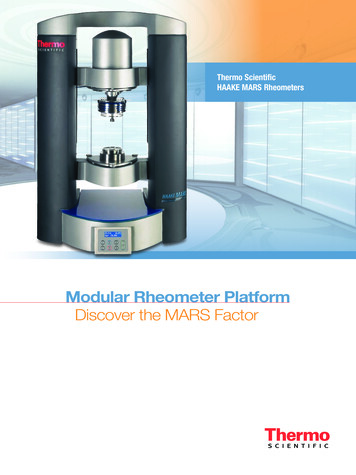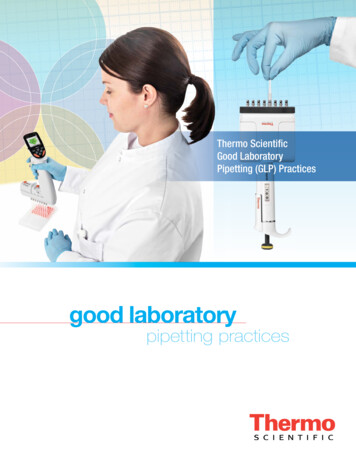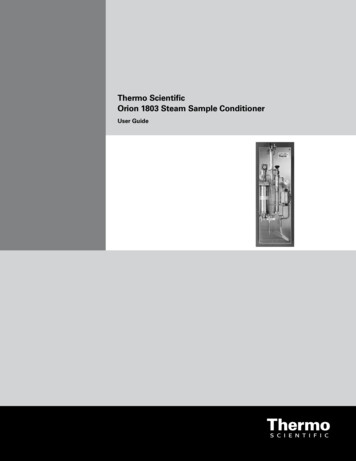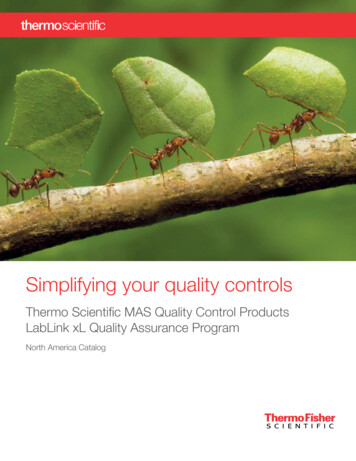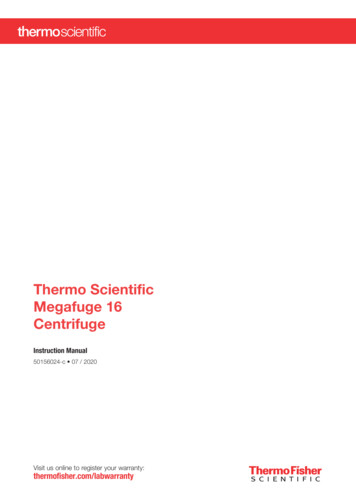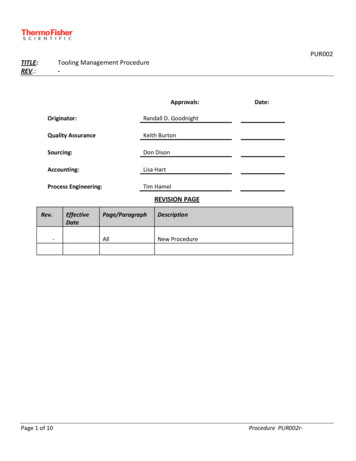
Transcription
PUR002TITLE:REV.:Tooling Management Procedure-Approvals:Originator:Randall D. GoodnightQuality AssuranceKeith BurtonSourcing:Don DisonAccounting:Lisa HartProcess Engineering:Tim HamelDate:REVISION PAGERev.EffectiveDate-Page 1 of 10Page/ParagraphDescriptionAllNew ProcedureProcedure PUR002r-
PUR002TITLE:REV.:1.Tooling Management Procedure-PurposeThe purpose of this procedure is to clearly define the tooling management requirements and process for suppliersdelivering parts or performing services to Thermo Fisher Scientific (TFS), Asheville, NC. This procedure defines thesupplier’s responsibility for design, fabrication, and handling of TFS owned tooling. It also establishesrequirements for records and reports associated with the maintenance and disposition of TFS tooling.2.ScopeThis procedure applies to all direct material and service suppliers. It applies to all tooling either furnished to,fabricated or procured by the suppliers under a TFS purchase order or other authorizing document, and includestooling located at a supplier’s lower tier supplier.Expendable tools, shop equipment, and capital tooling are specifically excluded from this procedure.3.Supplier Compliancea.All tooling including the designs and specifications that were purchased by TFS and/or provided to thesupplier for the purpose of producing product or performing services for TFS remain the property of TFS.b.Suppliers are to only use TFS tooling for producing product and performing services for TFS. Any otheruse is strictly prohibited and can only be done with the written consent of TFS.c.TFS has the right to remove all and/or any tooling at the Supplier at any time upon verbal and writtennotices which may includes electronic media.d.Suppliers are responsible for meeting all the requirements defined within this procedure. Failure to do so mayresult in the removal of all tooling from the supplier’s premises.e.The Suppliers are expected to meet all on-time delivery from tooling owned by TFS under normal use.f.Suppliers are responsible for achieving 100% part conformance to TFS drawings and specifications. For itsachievement, suppliers must ensure that the tooling is inspected to applicable data (engineering data,engineering drawings, master layouts, tool design, control tool, etc.) as specified in the purchase orderprior to release to production. It is understood that TFS owns all design drawings and specifications. TFSwill be forward a copy of all tooling design drawings per guidelines of this procedure.g.In the event that the supplier recommends any change to the print / tooling, a TFS, ECR, must beh.Suppliers are responsible for pursuing continuous improvement activities that will support and ensureflawless tooling reliability.i.Failure to meet these requirements may result in the loss of existing or future business with TFS. Any and allcosts associated with the supplier’s failure to comply with this procedure will be the responsibility of thesupplier.j.TFS will be allowed to visit the supplier for full process and tooling audits at TFS discretion. TFS will notify thesupplier of such audits with three working days from the time of audit.Page 2 of 10Procedure PUR002r-
PUR002TITLE:REV.:4.Tooling Management Procedure-ReferencesSupplier Quality ManualAddendum Supplier Quality Manual – AshevilleMetal Forming Checksheet FormTest Tooling Checksheet FormPlastic Molding Checksheet FormSupplier’s Acceptance Management AgreementSupplier Master Tooling/Fixture ListManufacturing Feasibility Analysis formPart Deviation RequestSupplier Part Approval PC030FPC022FPC023Definitions5.1Tooling/Tools - All test equipment, test fixtures, measuring devices, molds, jigs, dies, patterns, taps,gages, templates and other manufacturing aids made for and limited to the production of particulardetail parts and assemblies for TFS.5.2PCBA - Printed Circuit Board Assembly5.3Test Equipment - A single or multipurpose test unit designed, developed, fabricated, modified, orprocured to TFS specifications. Also a single or multipurpose test unit used to develop, produce, test,service, or measure parts. It may consist of a single item or an assembly, including standard or generalpurpose items or components that are interconnected and inter-dependent, so as to become newfunctional entity.5.4Expendable Tooling - These tools consist of catalogue items readily available on the open market, which,because of their size and nature are considered expendable. Drills, reamers, snap gauges, electrodes andall types of cutting tools are considered expendable tools, even though they are altered for productionpurposes and may be special in nature.5.5Shop Equipment and Capital Tools - These tools include supplier owned plant equipment such as:machines, motors, cranes, etc. Suppliers shall utilize any/all supplier owned shop equipment, which isnot to be included in tooling quotations for support of production.5.6ECR - Engineering Change Order5.7DC - Document ControlPage 3 of 10Procedure PUR002r-
PUR002TITLE:REV.:6.Tooling Management Procedure-Manufacturing Feasibility Considerations6.1TFS has considered control questions, although not intended to be all-inclusive, for suppliers to performa feasibility evaluation. The drawings and/or specifications provided to the supplier must be used as abasis for analyzing its ability to meet all specified requirements from TFS.6.2The Manufacturing Feasibility Analysis Form FPC030 is required to be completed by the supplier to helpTFS understand the extent of its process capability and feasibility to meet the drawings and/or specifications.The areas of the feasibility evaluation will include, but not limited to the following areas:6.27.1)Engineering2)Manufacturing3)Quality / Inspection4)Capacity Planning5)Cost Analysis6)StatisticalThe Manufacturing Feasibility Analysis Form shall be published and sent to TFS Sourcing when newbusiness, new tooling, tooling relocation or tooling transfer is confirmed and prior to commencement ofproduction.Tooling Packaging and Shipping7.1TFS and the supplier will agree upon the packaging specifications for the tooling during the tooldevelopment phase. The agreed upon specification will be detailed on the tooling purchase order.7.2It is the supplier’s responsibility to provide adequate packaging to protect TFS tooling during shipping. The basic requirements for packaging and shipment will include:Page 4 of 101)Packaging shall be sufficiently robust to protect the tooling. The packaging must be robustenough to prevent damage or contamination during tooling shipment.2)TFS may require an independent evaluation of the tooling after shipment for validationpurposes when damage is suspected or found after shipment from the supplier’s premises.3)All packaging must be labeled as specified for all tooling delivered.4)There shall be only one part number for each tool and only one part number on eachshipping container unless otherwise agreed upon with TFS.5)Suppliers are responsible for providing all shipping and release documents in a timelymanner as required. Any failure to do so may result in fees and expedited freight costProcedure PUR002r-
PUR002TITLE:REV.:Tooling Management Procedureincurred on the part of the supplier.7.38.9.10.In the event that any of these parameters are not met the tooling may be rejected upon delivery andshipping cost will be the responsibility of the supplier at the discretion of TFS.Tooling Storage:8.1Suppliers are responsible for the safe storage of the fixtures, tooling, and test equipment. Thisresponsibility extends to damage and risk of loss from the time it is delivered to supplier until it isreturned to TFS.8.2All tooling components and parts supplied by TFS to its suppliers for purposes of manufacturingproducts for TFS shall be stored in a manner that maintains the integrity of those materials and theiradherence to their specifications. Suppliers are expected to store them in such a manner as to keepthem safe from damage or loss.New Tooling9.1TFS highly recommends that the production supplier be integrated into the design process for newtooling. TFS requires the production supplier to manage new tooling projects. This would includethe development of prototype tooling and prototype components. This involvement allows for asmoother introduction of production tooling at the supplier. It will also help enable suppliers toconsistently produce high quality parts while meeting the desired process capabilities. This projectmanagement requirement includes the development of a formal project plan.9.2All parts produced from new production tooling must go through the required qualification process,including PPAP as directed by the TFS Supplier Engineering Department. Modifications to the tooldesign that occur during or after the qualification process may require parts to go through a portion or allof the qualification process a second time. Suppliers are encouraged to raise the issue of potentialdifferent requirements (i.e. cosmetic) for TFS parts and accessories during this initial qualificationprocess.9.3These project plans are expected to be updated and delivered to the designated representatives at TFSSourcing on a regular basis, which will be predetermined by TFS. TFS Engineering, Quality, and SourcingDepartments must be notified immediately of any major changes to the original project plan that mayimpact the quality or timing of the new tool.Tooling Identification and Traceability10.1Tooling identification and traceability are essential requirements for proper management of TFS tooling.The tooling shall be identified to include the part number, serial number, detachable components, andownership.10.2If the tool requires modification as a result of purchase order change, then the tool identification must reflectPage 5 of 10Procedure PUR002r-
PUR002TITLE:REV.:Tooling Management Procedurerevision A, B, etc., as applicable a TFS Sourcing will be notified prior to replacement.10.3The tooling must be properly named and properly tagged with a TFS identification number supplied byTFS. Whenever practical, tools shall be identified by means of a metal tool identification tag to be affixed uponthe tool.10.4If tool tags are impractical because of the design and/or material, tooling identification shall beaccomplished as described below.10.4.1 Metal tools shall be identified by acid etching, electro-engraving, vibropeening, steel stamping,laser etching or any other method that will permanently identify, but not damage the tools.10.4.2 Wood and plastic tools shall be identified by impressing, stenciling, or stamping. Tools too smallfor any of the above methods shall be boxed and/or chained/affixed to a tool tag to ensure theirproper identity.10.4.3 Regardless of identification method applied, suppliers must ensure that the identificationnumber is maintained in good condition at all times, and will not be removed or altered inanyway once affixed to the tooling. Should the identification number become damaged orineligible in any respect, the supplier agrees to immediately notifying TFS and replacing thedamaged tag with a new one from TFS.10.4.4 The name, identification number, a photo of each tool together with the part it produces mustbe taken and included for all tools that are documented on the Supplier Tooling/Fixture MasterList, FPC029 and sent to Sourcing by June 30, of each calendar year.10.4.5 The production tooling payment on any new sourcing awards is contingent upon that alltooling is tag in accordance with this procedure. Once the supplier submits the digitalpictures of the tooling with clear permanent identification that states that this tooling is’Property of TFS’ and shows our tooling order number only then payment is released tothe supplier for the tooling cost11.Tool Maintenance and Reporting11.1Suppliers are responsible for performing all maintenance work, repairs and component replacements asnecessary to ensure tooling remains in good working condition and suitable for its intended use.11.2Any maintenance required that exceeds what is considered to be normal wear and tear of thetooling, any component replacements, and repair work must be documented and reported to TFSSourcing immediately upon discovery. Such work shall have prior approval from TFS beforeperformed.Page 6 of 10Procedure PUR002r-
PUR002TITLE:REV.:Tooling Management Procedure11.3Suppliers must have effective systems in place for completing proper maintenance on TFS tooling atperiodic intervals so that optimal tooling performance and conditioning are ensured as set forth priorto approval by TFS.11.4When the tooling is not in use or is taken out for service, TFS requires that it be stored in a manner thatmaintains its integrity, and does not put it at risk for possible loss or damage.11.5Suppliers shall report to TFS Sourcing on an annual basis regarding the condition of the tooling, itsremaining life expectancy and should be used in the quality production of TFS production parts. Theappropriate and required forms for tracking the current condition of the tooling are an integrate part ofthis procedure and are listed in this section below. Although these forms are self explanatory for dataentry purposes, the TFS Supplier Quality Department is available for guidance in completing the form(s)as needed.There are three forms that are available and each form is representative of the different types oftooling that can apply. The forms are as follows:11.612.1)Metal Forming Checksheet Form, FPC0252)Test Tooling Checksheet Form, FPC0263)Plastic Molding Checksheet Form, FPC027When a supplier is notified by TFS of a part problem that may relate to the tooling, a team must beassembled by the supplier to determine root cause and corrective action. TFS recommends suppliers usethe industry standard Global 8-D problem solving methodology and submit results to TFS upon completion.Tooling Calibration (Test Equipment & Measuring Devices)12.1TFS requires calibration to be performed on test equipment and measuring devices in accordancewith the specification provided from TFS or the original equipment manufacturer.12.2All calibration results will be documented on the supplier’s internal calibration document(s) andforwarded to the designated TFS Sourcing representative at the predetermined calibration intervalestablished by TFS Sourcing for the equipment.Calibration reports should include at the minimum the following data:12.3Page 7 of 101)Manufacturer2)Tool Name3)Serial Number4)Tool ID Number5)Calibration Cycle6)Last Calibration DateProcedure PUR002r-
PUR002TITLE:REV.:13.Tooling Management ProcedureCalibration Due Date8)Initial of Person Performing the CalibrationTooling Changes13.113.214.7)Any change to the tooling, the process where the tooling is used, or the physical location of the toolingMUST have prior approval by TFS before implementation of the change. Furthermore, TFS shall benotified immediately and in advance once the supplier has made firm plans to make such changes. Allproposed changes must be documented on an Form FPC022 ( Supplier Part Deviation Request) andForm FPC023 (Supplier Part Approval Request) for TFS, review prior to any changes or temporarychanges that may affect any drawing, tooling or any documentation that may pertinent to the toolingproduction concerning TFS. Both these forms will be provided by TFS upon request.Failure to notify TFS in advance or failure to obtain prior approval can result in immediate containmentof parts produced and 100% inspection of such at the supplier’s expense. Further consequences mayinclude “New Business Hold” and/or the immediate loss of the existing business.Tooling Transfers14.1Any tooling that is being transferred should be done so by ensuring the following:All tooling shall be identified as specified in the Tooling Identification and Traceability section ofthis procedure.The transfer of all related documentation and software available including drawings,specifications, recent run records, and maintenance records, etc.The transfer of all TFS owned measuring tools, gauges, electronic measuring devices, spare parts,paint chip coupons, etc.14.215.In cases where the tooling is transferred from one supplier to another supplier, the transferee mustcomplete the Manufacturing Feasibility Analysis form FPC030 as described in section ManufacturingFeasibility Considerations of this procedure.Tooling Not In Service15.1When the tooling is not in use or is taken out of service, TFS requires that it be stored in a manner thatmaintains its integrity, and does not put it at risk for possible loss or damage.15.2TFS considers it’s tooling to be obsolete when:15.2a The tooling is no longer capable of producing parts that consistently meet the required qualitystandards within acceptable process parameters or15.2b The product it is producing is considered obsolete.15.3Page 8 of 10All potential repair options must be exhausted before the production tool can be deemed unusableor obsolete. TFS only considers a product to be obsolete if there is no potential for future demand,including service requirements, for that particular product.Procedure PUR002r-
PUR002TITLE:REV.:Tooling Management Procedure15.416.17.Once a tool has been determined obsolete, the supplier must contact the appropriate TFS Sourcingrepresentative for further direction regarding the disposition of the tool. The supplier must also notifyTFS if there are any components that can be salvaged from the tool. TFS will then determine whether todestroy, store, or return the tooling to TFS.Tooling and Product Verification16.1TFS Sourcing representative shall be afforded the right to verify at the supplier’s premises that the TFStooling conforms to requirements specified by TFS. Such verification shall not be used by the supplier asevidence of effective quality control. Under normal operating conditions of the tooling, the control of qualityfor the parts produced from the tooling is the sole responsibility of the supplier.16.2Verification by TFS shall not absolve the supplier of the responsibility to provide acceptable product, norshall it preclude subsequent rejection by the customer. Upon request, the supplier is required to provideverification that product from the tooling being produced meets all print specifications and requirements.Records17.1Suppliers shall maintain adequate records for all TFS tooling in accordance with the supplier’s QualityManagement System. It is necessary for the records to reflect the following:Ownership and contract (purchase order number) under which the tools are fabricatedPart number and serial numberNomenclature and descriptionLocation of toolsRework and/or TFS disposition authority for tools no longer in the supplier’s possession17.2Suppliers shall maintain current tool designs, schematic drawings, sketches and photographs used in thefabrication, testing or calibration of tooling for future references and/or revisions.17.3Tool manufacturing tolerances will be shown on the tool design. Disposition of this data will be made atthe same time the disposition of the related tool is provided.17.4TFS – Asheville will maintain the following records:RecordPage 9 of 10RetentionLocationIndex MethodMetal Forming Checksheet FPC0257 yrsDCElectronicTest Tooling Checksheet FPC0267 yrsDCElectronicPlastic Molding Checksheet FPC0277 yrsDCElectronicProcedure PUR002r-
PUR002TITLE:REV.:Tooling Management Procedure-Record18.RetentionLocationIndex MethodManufacturing Feasibility Analysis FPC0307 yrsDCElectronicPart Deviation Request FPC0227 yrsDCElectronicSupplier Part Approval Request FPC0237 yrsDCElectronicSUPPLIER ACCEPTANCE AND AGREEMENT18.1This procedure shall govern the possession and use of all TFS owned tooling. For the tooling that is nowin the possession by the supplier or that may be placed in the possession of the supplier is subject to therequirement set forth in this pro
engineering drawings, master layouts, tool design, control tool, etc.) as specified in the purchase order prior to release to production. It is understood that TFS owns all design drawings and specifications. TFS will be forward a copy of all tooling desi
